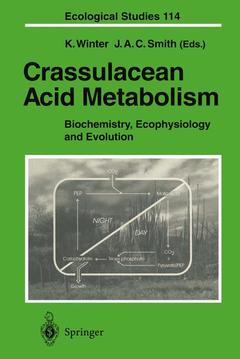Description
Crassulacean Acid Metabolism, Softcover reprint of the original 1st ed. 1996
Biochemistry, Ecophysiology and Evolution
Coll. Ecological Studies, Vol. 114
Coordinators: Winter Klaus, Smith J.Andrew C.
Language: French
Subjects for Crassulacean Acid Metabolism:
Publication date: 12-2011
449 p. · 15.5x23.5 cm · Paperback
449 p. · 15.5x23.5 cm · Paperback
Description
/li>Contents
/li>Comment
/li>
Crassulacean acid metabolism (CAM) represents one of the best-studied metabolic examples of an ecological adaptation to environmental stress. Well over 5 % of all vascular plant species engage in this water-conserving photosynthetic pathway. Intensified research activities over the last 10 years have led to major advances in understanding the biology of CAM plants.
New areas of research reviewed in detail in this book include regulation of gene expression and the molecular basis of CAM, the ecophysiology of CAM plants from tropical environments, the productivity of agronomically important cacti and agaves, the ecophysiology of CAM in submerged aquatic plants, and the taxonomic diversity and evolutionary origins of CAM.
New areas of research reviewed in detail in this book include regulation of gene expression and the molecular basis of CAM, the ecophysiology of CAM plants from tropical environments, the productivity of agronomically important cacti and agaves, the ecophysiology of CAM in submerged aquatic plants, and the taxonomic diversity and evolutionary origins of CAM.
An Introduction to Crassulacean Acid Metabolism. Biochemical Principles and Ecological Diversity.- Discovery of Dark CO2 Fixation.- Biochemistry.- Phenotypic Plasticity.- Ecophysiology and Species Diversity.- Conclusions.- References.- A: Biochemistry of Carbon Flow During Crassulacean Acid Metabolism: Preface.- 1 Stoichiometric Nightmares: Studies of Photosynthetic O2 and CO2 Exchanges in CAM Plants.- 2 Alternative Carbohydrate Reserves Usedin the Daily Cycle of Crassulacean Acid Metabolism.- 3 Roles of Circadian Rhythms, Light and Temperature in the Regulation of Phosphoenolpyruvate Carboxylase in Crassulacean Acid Metabolism.- 4 Transport Across the Vacuolar Membrane in CAM Plants.- 5 The Tonoplast as a Target of Temperature Effects in Crassulacean Acid Metabolism.- 6 Regulation of Crassulacean Acid Metabolism in Kalanchoe pinnata as Studied by Gas Exchange and Measurements of Chlorophyll Fluorescence.- 7 Energy Dissipation and the Xanthophyll Cycle in CAM Plants.- B: Environmental and Developmental Control of Crassulacean Acid Metabolism: Preface.- 8 Factors Affecting the Induction of Crassulacean Acid Metabolism in Mesembryanthemum crystallinum.- 9 Transcriptional Activation of CAM Genes During Development and Environmental Stress.- 10 Environmental Control of CAM Induction in Mesembryanthemum crystallinum - a Role for Cytokinin, Abscisic Acid and Jasmonate?.- 11 Regulation of Crassulacean Acid Metabolism by Water Status in the C3/CAM Intermediate Sedum telephium.- 12 Putative Causes and Consequences of Recycling CO2 via Crassulacean Acid Metabolism.- 13 Ontogenetic Development of Crassulacean Acid Metabolism as Modified by Water Stress in Peperomia.- 14 Crassulacean Acid Metabolism in Leaves and Stems of Cissus quadrangularis.- 15 Variations in the Phases of Crassulacean Acid Metabolism and Regulation of Carboxylation Patterns Determined by Carbon-Isotope-Discrimination Techniques.- C: Ecophysiology and Evolution of Crassulacean Acid Metabolism: Preface.- 16 High Productivity of Certain Agronomic CAM Species.- 17 Features of Roots of CAM Plants.- 18 Aquatic CAM Photosynthesis.- 19 Clusia: Plasticity and Diversity in a Genus of C3/CAM Intermediate Tropical Trees.- 20 Seasonal Changes in Daytime Versus Nighttime CO2 Fixation of Clusia uvitana In Situ.- 21 Crassulacean Acid Metabolism in the Genus Kalanchoe: Ecological, Physiological and Biochemical Aspects.- 22 Carbon-and Hydrogen-Isotope Discrimination in Crassulacean Acid Metabolism.- 23 Evolutionary Aspects of Crassulacean Acid Metabolism in the Crassulaceae.- 24 The Evolution of Crassulacean Acid Metabolism.- D.- 25 Crassulacean Acid Metabolism: Current Status and Perspectives.- 26 Taxonomic Distribution of Crassulacean Acid Metabolism.
This book gives a detailed overview of the major advances in understanding the biology of Crassulacean acid metabolism in (CAM) plants, from their biochemistry and molecular biology to fundamental aspects of their physiology, ecology and evolution.
© 2024 LAVOISIER S.A.S.




